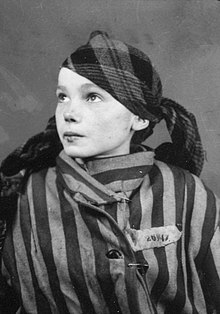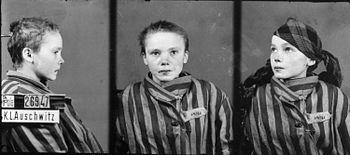Czesława Kwoka
Czesława Kwoka | |
|---|---|
 Kwoka as an inmate at Auschwitz concentration camp in late 1942 or early 1943 Photograph credit: Auschwitz-Birkenau State Museum and Wilhelm Brasse | |
| Born | 15 August 1928 |
| Died | 12 March 1943 (aged 14) Auschwitz, German-occupied Poland |
| Known for | being one of thousands of victims of Nazi crimes against ethnic Poles whose "identity pictures" were taken at Auschwitz |
| Parent(s) | Katarzyna and Paweł Kwoka[1] |
| Personal details | |
| Nationality | Polish |
| Religion | Roman Catholic |
Czesława Kwoka (15 August 1928 – 12 March 1943) was a Polish Catholic girl who was murdered at the age of 14 in Auschwitz.[2][3] One of the thousands of minor child and teen victims of German World War II war crimes against ethnic Poles in German-occupied Poland, she is among those memorialized in an Auschwitz-Birkenau State Museum exhibit, "Block no. 6: Exhibition: The Life of the Prisoners".[1][4]
Photographs of Kwoka and others, taken by the "famous photographer of Auschwitz", Wilhelm Brasse, between 1940 and 1945, are displayed in the Museum's photographic memorial. Brasse discusses several of the photographs in The Portraitist, a 2005 television documentary about him.[5][6][7][8]
Early life
[edit]Czesława Kwoka was born in Wólka Złojecka, a small village in Poland, to Roman Catholic parents: a mother, Katarzyna (née Matwiejczuk), and a father, Paweł.[9]
Deportation to Auschwitz
[edit]Along with her mother (prisoner number 26946), Kwoka (prisoner number 26947) was deported from her village, and transported from a resettlement camp at Zamość, General Government, to Auschwitz, on 13 December 1942, during Operation Zamość which was initiated in November that year to create Lebensraum for Germans in eastern Europe.[1][10]
Kwoka was one of the "approximately 230,000 children and young people aged less than eighteen" among the 1,300,000 people who were deported to Auschwitz from 1940 to 1945.[11] Most of these children "arrived in the camp along with their families as part of the various operations that the Nazis carried out against whole ethnic or social groups". Of all these children and young people, "only slightly more than 20,000 ... including 11,000 Gypsies, were entered in the camp records. No more than 650 of them survived until liberation [in 1945]."[11]
Photographs of Kwoka
[edit]
After her arrival at Auschwitz, Kwoka was photographed for the Reich's concentration camp records, and she was identified as one of the approximately 40,000 to 50,000 subjects of such "identity pictures" taken under duress at Auschwitz-Birkenau by Wilhelm Brasse, a young Polish inmate in his twenties (known as Auschwitz prisoner number 3444).[12] Trained as a portrait photographer at his aunt's studio prior to the 1939 German invasion of Poland beginning World War II, Brasse and others had been ordered to photograph inmates by their Nazi captors under threat.[13]
These photographs that he and others were ordered to take capture each inmate "in three poses: from the front and from each side."[13] Though ordered to destroy all photographs and their negatives, Brasse became famous after the war for having helped to rescue some of them from oblivion.[5][6][7] He recounted his photographs of Kwoka specifically in The Portraitist, a Polish documentary about his life and experiences at Auschwitz.
Death
[edit]On 12 March 1943, less than a month after her mother's death on 18 February, Kwoka was murdered at the age of 14; the circumstances of her death were not recorded.[1] Her death certificate, issued on 23 March, falsely noted that she died of cachexia from intestinal catarrh.[9] Reports indicate that the real cause of death was a phenol injection to the heart.[2][3]
Legacy
[edit]Memorial exhibits
[edit]While most photographs of Auschwitz inmates (both victims and survivors) no longer exist, some photographs do populate memorial displays at the Auschwitz-Birkenau State Museum, where the photographs of Kwoka reside, and at Yad Vashem, Israel's official memorial to the Jewish victims of the Holocaust.[7][8]
Captions attached to the photographs in the Auschwitz-Birkenau State Museum photo archives and memorial indoor exhibits have been constructed by the Museum Exhibition Department from camp registries and other records confiscated when the camps were liberated in 1945 and archived subsequently. These Museum photo archive captions attached to photographs assembled and/or developed from photographs and negatives rescued by Brasse and fellow inmate darkroom worker Bronislaw Jureczek during 1940 to 1945 identify the inmate by name, concentration-camp prisoner number, date and place of birth, date of death and age at death (if applicable), national or ethnic identity, religious affiliation, and date of arrival in the camp.[1][5][6][7] Some photographs credited to Brasse, including the "identity picture" with 3 poses of Kwoka, are in the Auschwitz-Birkenau State Museum's memorial to prisoners, part of a permanent indoor exhibit called Block no. 6: Exhibition: The Life of the Prisoners, first mounted in 1955.
Kwoka's likeness is also featured by the museum's Exhibition Department on its official website,[4] in some of the Museum's published albums and catalogues,[11] and in the documentary The Portraitist.
The photo mural including Kwoka's "identity pictures" ("identification photographs" or "mug shots") displayed on a wall in the Auschwitz-Birkenau State Museum's permanent indoor exhibition The Life of the Prisoners in Block no. 6 is captured in Ryszard Domasik's photograph cropped (without the photographs of Kwoka) featured on its official Website.[4]
Art
[edit]"Bring[ing] Czeslawa's image and voice into our lives", Theresa Edwards (verse) and Lori Schreiner (art) created Painting Czesława Kwoka, a collaborative work of mixed media inspired by Brasse's photographs, as a commemoration of child victims of the Holocaust.[14][15][16]
On the 75th anniversary of her death, a colorized version of the photographs was published by Brazilian artist Marina Amaral.[17][10]
See also
[edit]- Kinder KZ, a Nazi concentration camp for children in Łodź, Poland
Notes
[edit]- ^ a b c d e "Kwoka: Czesława Kwoka". Auschwitz-Birkenau Memorial and Museum. Auschwitz-Birkenau State Museum. Retrieved 29 August 2008. [dead link]
- ^ a b Pearson, Alexander (19 March 2018). "Color photo of girl at Auschwitz strikes chord". Deutsche Welle. Retrieved 12 July 2023.
- ^ a b Zalewska, Maria (July 2018). "'Faces of Auschwitz': Learning History In Color" (PDF). Memoria. Auschwitz-Birkenau State Museum. p. 28. Retrieved 12 July 2023.
- ^ a b c "Block no. 6: Exhibition: The Life of the Prisoners". Auschwitz-Birkenau State Museum, Poland. 5 October 2006. Archived from the original on 18 October 2007. Retrieved 3 September 2008.
- ^ a b c Struk, Janina (20 January 2005). "I will never forget these scenes'". The Guardian. Retrieved 28 August 2008.
- ^ a b c Struk, Janina (2003). Photographing the Holocaust: Interpretations of the Evidence. New York and London: I.B. Tauris, 2004. ISBN 978-1-86064-546-4.
- ^ a b c d Lucas, Ryan (8 July 2008). "Auschwitz Photographer, Wilhelm Brasse, Still Images". Imaginginfo.com. Cygnus Business Media. Archived from the original on 28 May 2007. Retrieved 29 August 2008.
- ^ a b Shoffman, Marc (15 March 2007). "The Auschwitz Photographer". TotallyJewish.com. Jewish News Online. Archived from the original on 14 September 2008. Retrieved 29 August 2008.
- ^ a b Białecka, Alicja; Oleksy, Krystyna; Regard, Fabienne; Trojański, Piotr (December 2010). "European pack for visiting Auschwitz-Birkenau Memorial and Museum". Council of Europe Publishing. p. 258.
- ^ a b Frymorgen, Tomasz (15 March 2018). "An artist coloured in a photo of an Auschwitz victim and it's heartbreaking". BBC Three. Retrieved 8 September 2021.
- ^ a b c "To Forget about Them Would Be Unthinkable – The Youngest Victims of Auschwitz: A New Album Devoted to the Child Victims of the Auschwitz Camp". Latest News (1999–2008) (Press release). Auschwitz-Birkenau State Museum. 6 June 2003. Archived from the original on 30 September 2006. Retrieved 29 August 2008.
- ^ "Wilhelm Brasse". Auschwitz-Birkenau Memorial and Museum. Auschwitz-Birkenau State Museum. Retrieved 29 August 2008. [dead link]
- ^ a b Hevesi, Dennis (24 October 2012). "Wilhelm Brasse Dies at 94; Documented Nazis' Victims". The New York Times. Archived from the original on 25 October 2012. Retrieved 17 January 2015.
- ^ Schreiner, Lori; Edwards, Theresa. "Painting Czesława Kwoka". AdmitTwo (A2). 19 (September 2007). admit2.net. Archived from the original on 13 August 2019. Retrieved 28 August 2008.
- ^ "Words & Images: A Collaboration" (PDF) (Press release). Windham Art Gallery. May 2007. Archived from the original (PDF) on 19 August 2008. Retrieved 28 August 2008.
- ^ Potter, Jon (14 June 2007). "Thinking Outside the Book: Words and Images Combine in Exciting New Ways at WAG". Brattleboro Reformer. nl.newsbank.com. Retrieved 28 August 2008. (Subscription or fee required for access to archived articles.)
- ^ Welle, Deutsche. "Auschwitz color photo: 'A 14-year-old girl, not just a statistic' | DW | 26.03.2018". DW.COM. Retrieved 8 September 2021.
References
[edit]- "Children during the Holocaust". United States Holocaust Museum Encyclopedia (Holocaust Encyclopedia). Accessed August 28, 2008. (Feature article.)
- Kubica, Helena. The Extermination at KL Auschwitz of Poles Evicted from the Zamość Region in the Years 1942-1943. "New Book from Auschwitz-Birkenau Museum: Memorial Book ... The Expulsion of Polish Civilians from the Zamosc Region". Auschwitz-Birkenau State Museum, Poland. July 17, 2004. Accessed August 29, 2008. (Press release.)
- –––. Nie wolno o nich zapomnieć/Man darf się nie vergessen Najmłodsze ofiary Auschwitz/Die jüngsten Opfer von Auschwitz. Auschwitz-Birkenau State Museum Publications. Państwowe Muzeum Auschwitz-Birkenau w Oświęcimiu, 2002. ISBN 978-83-88526-30-5. (Polish–German version.) Featured in Auschwitz–Birkenau: Memorial and Museum: A Brief History and Basic Facts. (Web PDF). Auschwitz-Birkenau State Museum, Poland. 27 pages.
- Lukas, Richard C. Did the Children Cry? Hitler's War against Jewish and Polish Children, 1939–1945. New York: Hippocrene Books, 2001. Project InPosterum: Preserving the Past for the Future, projectinposterum.org. Accessed August 28, 2008. (Excerpts from text.)
- –––. Photographing the Holocaust: Interpretations of the Evidence. New York and London: I.B.Tauris, 2004. ISBN 978-1-86064-546-4. Google Books. Accessed August 29, 2008.
External links
[edit]- Archives. United States Holocaust Memorial Museum (USHMM).
- Auschwitz-Birkenau Memorial and Museum. Auschwitz-Birkenau State Museum, Poland. English version.
